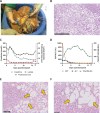Transplantation of Severely Steatotic Liver Grafts After Machine Perfusion Remains a Risky Challenge
- PMID: 40888693
- PMCID: PMC12290766
- DOI: 10.1111/ctr.70260
Transplantation of Severely Steatotic Liver Grafts After Machine Perfusion Remains a Risky Challenge
Abstract
Liver transplantation is the treatment of choice for patients with end-stage liver disease. However, donor shortages have increased the use of high-risk and extended criteria donor livers, including livers donated after circulatory death and those with severe steatosis. Severe donor liver steatosis is associated with poor outcomes due to high susceptibility to ischemia-reperfusion injury. Ex situ machine perfusion, combining hypothermic oxygenated perfusion and normothermic perfusion (termed the DHOPE-COR-NMP protocol), has emerged as a promising strategy to mitigate injury, assess liver viability, and improve transplant outcomes. Here, we present two patients who received very steatotic donor livers following resuscitation and viability assessment using DHOPE-COR-NMP. Although both steatotic donor liver functioned well during NMP and met all of our clinically validated viability criteria, the outcome after transplantation was complicated. One recipient suffered from pulmonary fat emboli syndrome, likely due to significant loss of fat from the donor liver. The second patient required retransplantation and histopathological examination of the donor liver revealed massive lipopeliosis in zones III of the explanted liver. With the increasing incidence of steatotic donor livers, further research to prevent steatosis-related posttransplant complications is becoming progressively important. At present, transplantation of severely steatotic liver grafts remains a risky challenge, even after ex situ machine perfusion.
Keywords: complication; donors and donation: extended criteria; liver biology.
© 2025 The Author(s). Clinical Transplantation published by Wiley Periodicals LLC.
Conflict of interest statement
The authors declare no conflicts of interest.
Figures


References
-
- Croome K. P., Lee D. D., and Taner C. B., “The “Skinny” on Assessment and Utilization of Steatotic Liver Grafts: A Systematic Review,” Liver Transplantation 25, no. 3 (2019): 488–499. - PubMed
-
- Rosenfeld D. M., Smith M. L., Seamans D. P., et al., “Fatal Diffuse Pulmonary Fat Microemboli Following Reperfusion in Liver Transplantation With the Use of Marginal Steatotic Allografts,” American Journal of Transplantation 19, no. 9 (2019): 2640–2645. - PubMed
-
- Baker P. L., Pazell J. A., and Peltier L. F., “Free Fatty Acids, Catecholamines, and Arterial Hypoxia in Patients With Fat Embolism,” Journal of Trauma 11, no. 12 (1971): 1026–1030. - PubMed
Publication types
MeSH terms
LinkOut - more resources
Full Text Sources
Medical
Miscellaneous

